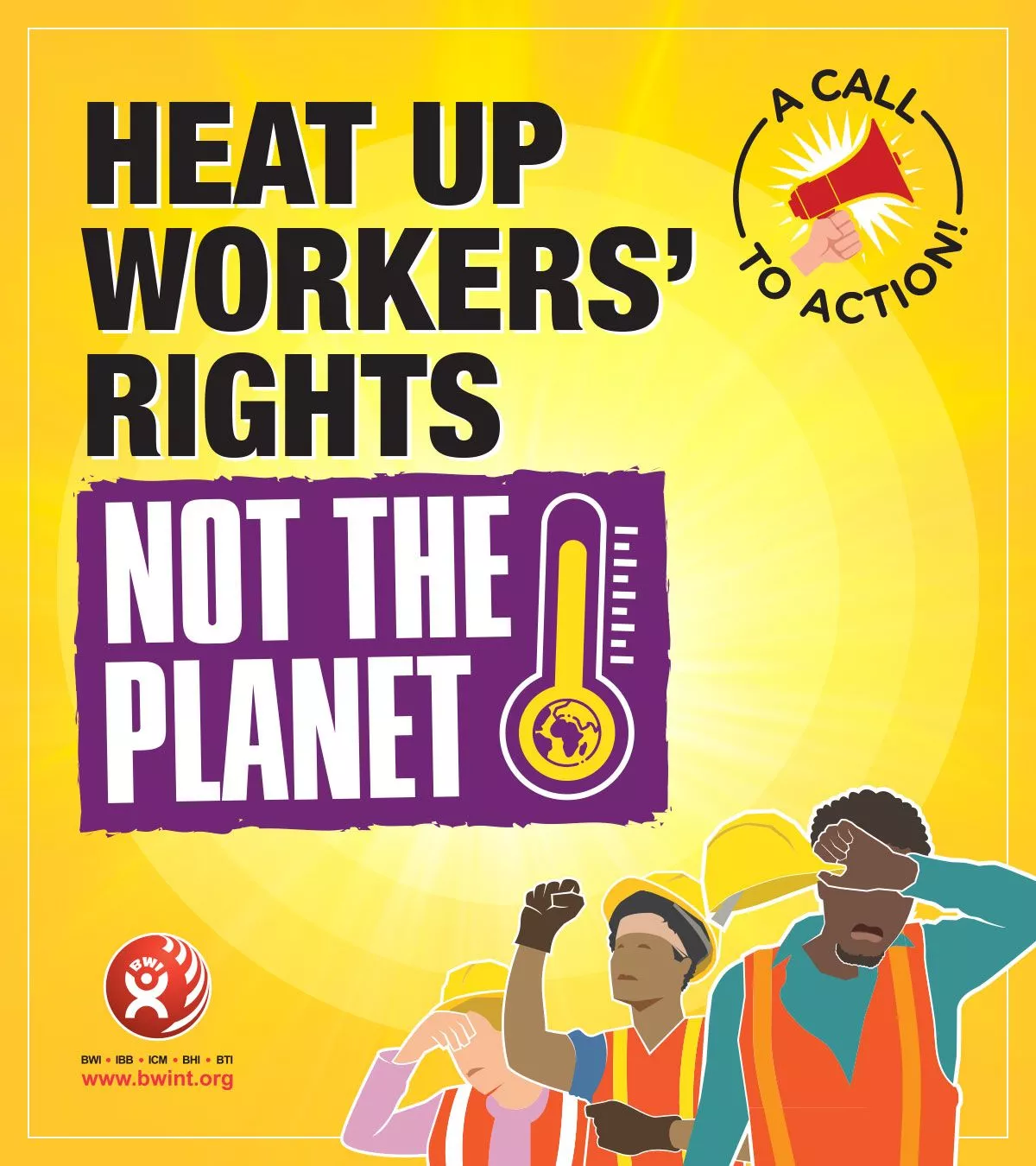29 November 2023
Feature: Too hot to work--What record heat means for construction migrant workers
(Photo: https://blog.ucsusa.org)
By Ambet Yuson, General Secretary, Building and Wood Workers’ International (BWI)
As world leaders prepare to set foot in Dubai - in the fastest warming region of the world - for the COP28, take a moment to reflect on what working in extreme heat is like. Join construction workers worldwide demanding urgent measures to protect workers from climate change-induced extreme heat.
Human-induced global warming and rising temperatures are bringing changes to the climate systems in every region of the world that are unprecedented. Extreme weather events are becoming the new normal and heatwaves are more frequent. They are severe and prolonged and are often too intense for workers to perform work. They can even be deadly.
Heatwaves and extreme temperatures have, in a short time, changed the way we work and live. The summer of 2023 focused the world’s attention on heat, with the biggest spikes in temperatures being attributed to the climate crisis.

If you are among the millions construction workers who have been scorching in summer to make a living, chances are that you remember what it was like to sweat in your boots or protective equipment, how dehydration, exposure to sun and physical effort doubled the fatigue and put you at risk of workplace injury, and how much you were yearning for a rest-break to cool off.
For many construction workers, body temperature became too hot for organs to work, bringing death on the job by heatstroke or cardio-vascular failures on the job. Others risked exacerbating respiratory or kidney diseases, diabetes, or other illnesses. For them and their families, the lethal effects of heat were not avoided - just delayed.
The World Health Organization (WHO) estimates that between 2030 and 2050, climate change will cause approximately 250.000 additional deaths per year, from malnutrition, malaria and heat stress.
Governments and employers must take their responsibility. Every avoidable fatality is murder.
Without urgent protective measures in place before heatwaves, damage to health and death will become the new normal for outdoor labourers especially in countries like those in the Gulf, where already long periods of extreme heat are becoming longer. In the likely event that global temperatures increase by 1.5°C, the number of hot days will surge by 51% in 2050, going from the current 100 to 150 days per year around 6 months per year.
Who is bearing the brunt of extreme heat?
Climate crisis-induced extreme climate events and severe and regular heatwaves are already taking its toll on the most vulnerable communities within and across countries, including women, young people and migrant workers. The struggle for migrant rights, in particular, and the climate crisis are connected as people are increasingly displaced in search of safety from climate disasters, or to contribute to the rebuilding efforts of their families and their communities when disasters hit. From its decades-long work on the ground, BWI has selected some elements:
- As more workers are forced into irregular, sudden and unsafe journeys, there is a higher risk that they enter into a new spiral of exploitation, debt bondage and abuse in the absence of safe and legal migration pathways.
- Many low to medium-skilled workers find work in the construction industry, where work is often informal and there is a high risk of exploitation.
- Where work is highly informal, heat waves exacerbate the problem of working hours lost due to extreme heat, pushing wages and conditions further down.
- Women workers in particular are pushed into greater informality to cope with caring responsibilities, e.g. home-based work in the brick or other materials’ industry, further deepening discrimination and exposure to gender-based violence risks.
- Where they exist, State heat-stress regulations are often offset by corporations opting to pay the fines for breaching them rather than absorbing the cost of adjusting project completion targets.
- Inadequate State controls, low penalties for abusive employers, the kafala-sponsorship system and the lack of trade union rights make it difficult for workers to report heat-related issues without fear of retaliation.
- Migrant workers often lack access to comprehensive remedial mechanisms at transnational scale when they are afflicted with illnesses due to prolonged exposure to heat stress, and for their families in countries of origin in the case of fatalities.
- Migrant workers pay the cost of climate change twice. Not only are they pushed into debt bondage as they are displaced from their lands when disasters hit. They also bear the cost of reconstruction with remittances, which are becoming increasingly significant despite being volatile and unsustainable solutions in the long run.

As forecasts show a continued rise in extreme temperatures for prolonged periods of time, work will soon become unsustainable for millions of migrant workers coming from all continents holding the most vulnerable positions in the Gulf countries and elsewhere.
The impact of extreme heat on construction workers, and in particular on migrant workers scorching for months under killer heatwaves has become an issue of human rights that must be addressed without delay.
Measures to build resilience focusing on immediate impacts or near-term risks are slowly taking root across communities. Trade unions are negotiating adaptation solutions that help build resilience to climate risks for workers and their increased health risks.
However, to scale measures up so that they bring broader sustainable benefits, governments need to step in with broader, universal, labour protection policies, the development of decent work, and alignment with international labour standards centreing on workers’ agency.

The right to a safe and healthy working environment is recognised by the ILO and the UN. In the construction sector, in the face of extreme weather events requires radical interventions that are human-centred.
At COP28, governments can decide to make the right to healthy and safe working environments more than words but as an inspiration to shape reality at the workplace.
Join the pledge.